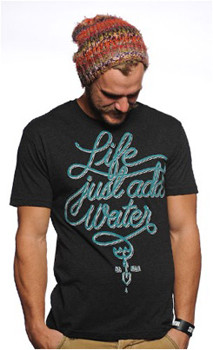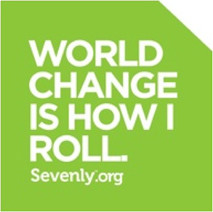It’s the causification of fashion: For every category of clothing or accessory, there’s a brand that markets itself as an easy, effective way to serve the social good. Two famous examples are Warby Parker (eyeglasses) and TOMS (shoes and eyeglasses), which donate a product to a person in need for every one bought at regular price. As an alternative to the one-for-one model, some companies simply choose to donate a fraction of all its proceeds to worthy charities. One such enterprise is Sevenly, whose name gives clue into its own particular twist. For seven days, it sells a “cause tee,” which is a shirt designed to reflect the cause of a partner nonprofit. For the nonprofit Freely in Hope, for instance, the text reads “Unlock Freedom” to hint at how the organization liberates “women and their families from the bondages of poverty.”
 Can you guess the nonprofit's mission from the design alone? If you guessed "to help children in Africa by building wells and sanitation systems at schools,” you are correct. Regardless, this shirt for Drop in the Bucket is a conversation starter.
Can you guess the nonprofit's mission from the design alone? If you guessed "to help children in Africa by building wells and sanitation systems at schools,” you are correct. Regardless, this shirt for Drop in the Bucket is a conversation starter.
Through an aggressive digital and social media campaign, Sevenly promotes these shirts to the buying public. In this way, Sevenly makes it incredibly convenient to support causes—you can buy a product you already need (a shirt), at a price similar to other designer brands ($22.00), all while giving a significant portion of that to a nonprofit ($7.00). And while they take care of the actual details of the donation, you can simply rock your beautiful, socially conscious shirt and feel good, which is an oft-cited motivation for charity and certainly one of mine. But how many of these customers take it upon themselves to go beyond conscious consumerism and make a deeper commitment with their time, money, or influence? After opening my box of TOMS shoes, all I did was puzzle over the inclusion of a flag.
 Here is a version of the flag in question. If Google image results are to be believed, the idea is to pose with it for a picture and then share the image with your connections on social media.
Here is a version of the flag in question. If Google image results are to be believed, the idea is to pose with it for a picture and then share the image with your connections on social media.
Much to Sevenly’s credit, many of its customers are doing more than just exercising their buying power and flag-waving, especially in the digital realm. Adam McKibben, the director of communications at Thirst Relief International, said it best: “The largest impact we saw was through social media.” Of the seven nonprofits interviewed for this article (I promise that number was not intentional), all but one attested to an influential boost of evangelizers on Twitter and Facebook. For Together We Rise, this influx also coincided with two thousand new sign-ups for their email list. Similarly, Love Without Boundaries gained one thousand new subscribers to their newsletter during their fundraiser, though CEO Amy Eldridge wished for a better way to “track who joined specifically due to Sevenly.”
 One of Sevenly’s pins from Pinterest. Its customers have shared info about nonprofits and their causes on social media close to four million times. I can count on one hand the number of times I have been retweeted, so I can safely say that's a lot.
One of Sevenly’s pins from Pinterest. Its customers have shared info about nonprofits and their causes on social media close to four million times. I can count on one hand the number of times I have been retweeted, so I can safely say that's a lot.
To put on my cynical hat for a moment, I could argue that all the traction on social media is nothing more than slacktivism at its self-righteous finest. Yes, the evangelizers increase the online reputation of a nonprofit, but their dialogue—if you want to euphemistically call comments and retweets that—does not advance its mission in any meaningful way. So, to evaluate them by another metric: Are Sevenly supporters putting their money where their mouths are? Danny Mendoza, CEO of Together We Rise, reported that the organization “received an increase in monetary donations” during the Sevenly campaign. Thirst Relief International got both the “one-time donors” you would expect as well as “reoccurring donors,” said Adam McKibben. Most promisingly, Compassion International gained thirteen sponsorships. In the words of Chris Giovagnoni, its social media program manager, these can be “considered a longer-term benefit because it’s a monthly commitment and sponsorships tend to last several years, as opposed to a one time donation.”
 With a team that makes supporting nonprofits look this fun, it’s easy to see why Sevenly supporters are making direct donations.
With a team that makes supporting nonprofits look this fun, it’s easy to see why Sevenly supporters are making direct donations.
Are you enjoying this article? Read more like this, plus SSIR's full archive of content, when you subscribe.
To keep my cynical hat on a little longer, I could make the case that even these donations are a form of slacktivism. Instead of retweeting updates and liking statuses they are using PayPal and linking credit cards, but the situation is still the same: They’re sitting comfortably in their armchairs. Thus another metric is in order: How many of the Sevenly supporters who want to change the world actually venture out into the world? Of our seven nonprofits, no volunteers came to them as a result of their campaign with Sevenly. This seems like a huge loss, given that the Sevenly community likely has the kind of professionals—lawyers, teachers, artists, designers, writers, entrepreneurs, marketers, doctors, and so on—that can make a game-changing, kick-starting difference for nonprofits.
 To compliment “Sevenlyisms” like this, Sevenly should encourage volunteering. Amy Eldridge suggested that it post an update such as: “All the Love Without Boundary programs are run 100 percent by volunteers. Do you have some free time this week?"
To compliment “Sevenlyisms” like this, Sevenly should encourage volunteering. Amy Eldridge suggested that it post an update such as: “All the Love Without Boundary programs are run 100 percent by volunteers. Do you have some free time this week?"
If this is asking too much, it’s because Sevenly can accomplish so much more. Ryan Day, the communications manager at Love146, hints at this very potential in his critique of Sevenly: “We’re firm believers that smart activism is testing out the shallow end and walking slowly, carefully and faithfully into the deep end, but Sevenly’s model easily allows for potential world changers to stay content and proud in the shallowest of waters.” I could replace “Sevenly” with the name of another social enterprise in fashion, and this criticism would still remain as legitimate. Companies like Sevenly, TOMS Shoes, and Warby Parker are exceptional at making us realize the power of conscious consumerism. Through them we witness how even a small action, such as buying a shirt or a pair of shoes, can enact tremendous good. To move forward, these social enterprises must emphasize that even greater change will come about once we habituate small actions into patterns and internalize patterns into regular behavior. In other words, these fashion companies need to encourage a lifestyle.
Support SSIR’s coverage of cross-sector solutions to global challenges.
Help us further the reach of innovative ideas. Donate today.
Read more stories by Ezra Ferraz.

